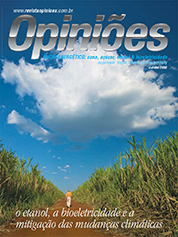Holger Brauer
Director of the Steam Turbines Division at Siemens
Op-AA-22
Ethanol and Bioelectricity: potential to reduce GHG
Climate change and its consequences represent a great danger for humanity. It is necessary to act quickly. Fortunately, nowadays one no longer questions the fact that the emission of carbon dioxide has a significant impact on the climate and that it is one of the causes of global warming. However, even the most recent calculation models cannot safely predict the actual consequences that this problem will have for all of us.
For that reason, the whole world is mobilizing to limit and reduce greenhouse gas emissions. Countries such as the United States or China, that in the past were more concerned about the growth of the economy than with the consequences of their economic activities for the environment, are reassessing this position and making changes to their environmental policies.
Brazil, as a country that already has a broad experience and many references concerning the use of renewable energy, has what it takes to be in a leading position in this new scenario. Ethanol and the energy produced based on biomass are a reality in Brazil, but have not even come close to the potential they could contribute to the energy matrix of Brazil and the world.
With the introduction of “flex” cars, ethanol in Brazil became a true alternative to gasoline. Unfortunately, there are still many barriers outside the country for the use of our “green” fuel. Exports, rather than grow, decreased during the year. Notwithstanding all the efforts made by representatives of the Brazilian sugar and ethanol industry, the country’s ethanol still has a negative image.
There are biases concerning the way how it is produced; some people even believe that by expanding sugarcane plantations, we are destroying the Amazon forest, among other myths that are circulated. We need to develop broad communication efforts to show the world that Brazilian reality is quite different.
Initiatives such as the demarcation of areas approved for planting sugarcane and audits of ethanol producers performed by independent entities, qualified to check and certify the production of our ethanol as being based on sustainable processes and criteria, without any negative impact on the environment, are examples of well-succeeded measures on this path, and help us do away with the bias.
Ethanol has not yet become a commodity. The global demand must grow, just like it is important that the production of ethanol in other countries develops, especially in neighboring countries in Latin America and in Africa, where there are also favorable climate conditions for planting sugarcane. Based on the experience of Brazil, one can develop ethanol as an alternative to gasoline, generating jobs and income for people in rural areas.
In parallel to ethanol, we are increasing the generation of electric power based on biomass and, in particular, on sugarcane bagasse. There has been a major change in the concept of sugar and ethanol mills, which in the past were designed to be self-sufficient, when there was no perspective of exporting surplus energy. Bagasse, a residue of the production process that one way or the other had to be incinerated, became a valuable fuel for thermoelectric plants.
Nowadays, new mills are being designed for self-generation, in the range between 50 and 100 MW, using highly efficient equipment, such as high-pressure boilers and turbines, among others, that allow for the sale of approximately 50% of the energy generated to the network. Applying this same standard of energy efficiency to older mills, one could increase the generation potential quite considerably, even not investing in new green field mills.
Following the influx of many funds into this segment, in 2007 and 2008, investment receded and thus the modernization process of the mills was interrupted. One problem is the lack of capital for investment, due to the financial crisis and a consolidation process in the industry. Apart from that, what is still lacking are clear conditions for investors. Investments viewed as viable in 2007, now have difficulty in getting approved. In addition, there is the fact that in the most recently held auctions, energy from biomass did not fare well.
Investments in thermoelectric plants that run on biomass (bagasse, wood, elephant grass, etc) have a relatively high specific value (R$/kW), in comparison with thermoelectric plants that run on gas or coal, but offset this fact with the reduction in carbon dioxide emissions. However, one must establish a minimum amount to sell MWh at amounts higher than those obtained with fossil fuel, or other regulatory measures.
An incentive is needed, which should be conditioned to a plant’s efficiency parameters, thereby generating a stimulus to achieve the technically feasible generation potential. Without such incentives for investment in energy generation based on biomass, one will not see stable growth of this clean and sustainable energy.




